MERCEDES-BENZ SLC-Class 2017 R172 Owner's Manual
Manufacturer: MERCEDES-BENZ, Model Year: 2017, Model line: SLC-Class, Model: MERCEDES-BENZ SLC-Class 2017 R172Pages: 294, PDF Size: 7.28 MB
Page 251 of 294
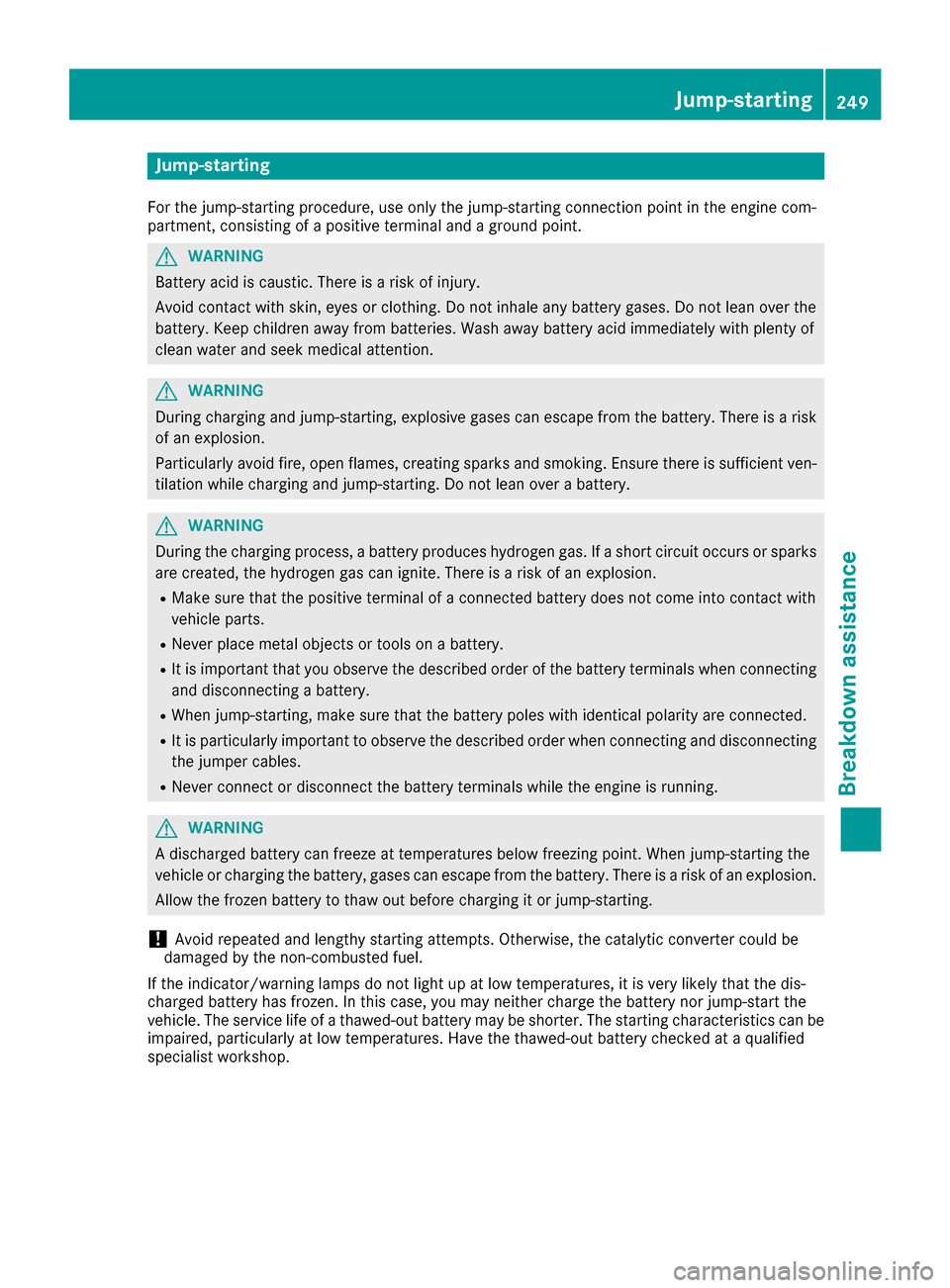
Jump-starting
For the jump-starting procedure, use only the jump-starting connection point in the engine com-
partment,consisting of apositive terminal and aground point.
GWARNING
Battery acid is caustic. There is arisk of injury.
Avoid contact with skin, eyes or clothing. Do not inhale any battery gases. Do not lean over the
battery. Keep children away from batteries. Wash away battery acid immediately with plenty of
clean water and seek medical attention.
GWARNING
During charging and jump-starting, explosive gases can escape from the battery. There is arisk
of an explosion.
Particularly avoid fire, open flames, creating sparks and smoking. Ensure there is sufficient ven-
tilation while charging and jump-starting. Do not lean over abattery.
GWARNING
During the charging process, abattery produces hydrogen gas. If ashort circuit occurs or sparks
are created, the hydrogen gas can ignite. There is arisk of an explosion.
RMake sure that the positive terminal of aconnected battery does not come into contact with
vehicle parts.
RNever place metal objects or tools on abattery.
RIt is important that you observe the described order of the battery terminals when connecting
and disconnecting abattery.
RWhen jump-starting, make sure that the battery poles with identical polarity are connected.
RIt is particularly important to observe the described order when connecting and disconnecting
the jumper cables.
RNever connect or disconnectt he battery terminals while the engine is running.
GWARNING
Ad ischarged battery can freeze at temperatures below freezing point. When jump-starting the
vehicle or charging the battery, gases can escape from the battery. There is arisk of an explosion.
Allow the frozen battery to thaw out before charging it or jump-starting.
!Avoid repeated and lengthy starting attempts. Otherwise, the catalytic converter could be
damaged by the non-combusted fuel.
If the indicator/warning lamps do not light up at low temperatures, it is very likely that the dis-
charged battery has frozen.Int his case, you may neither charge the battery nor jump-start the
vehicle. The service life of athawed-out battery may be shorter. The starting characteristicsc an be
impaired, particularly at low temperatures. Have the thawed-out battery checked at aqualified
specialist workshop.
Jump-starting249
Breakdown assistance
Z
Page 252 of 294
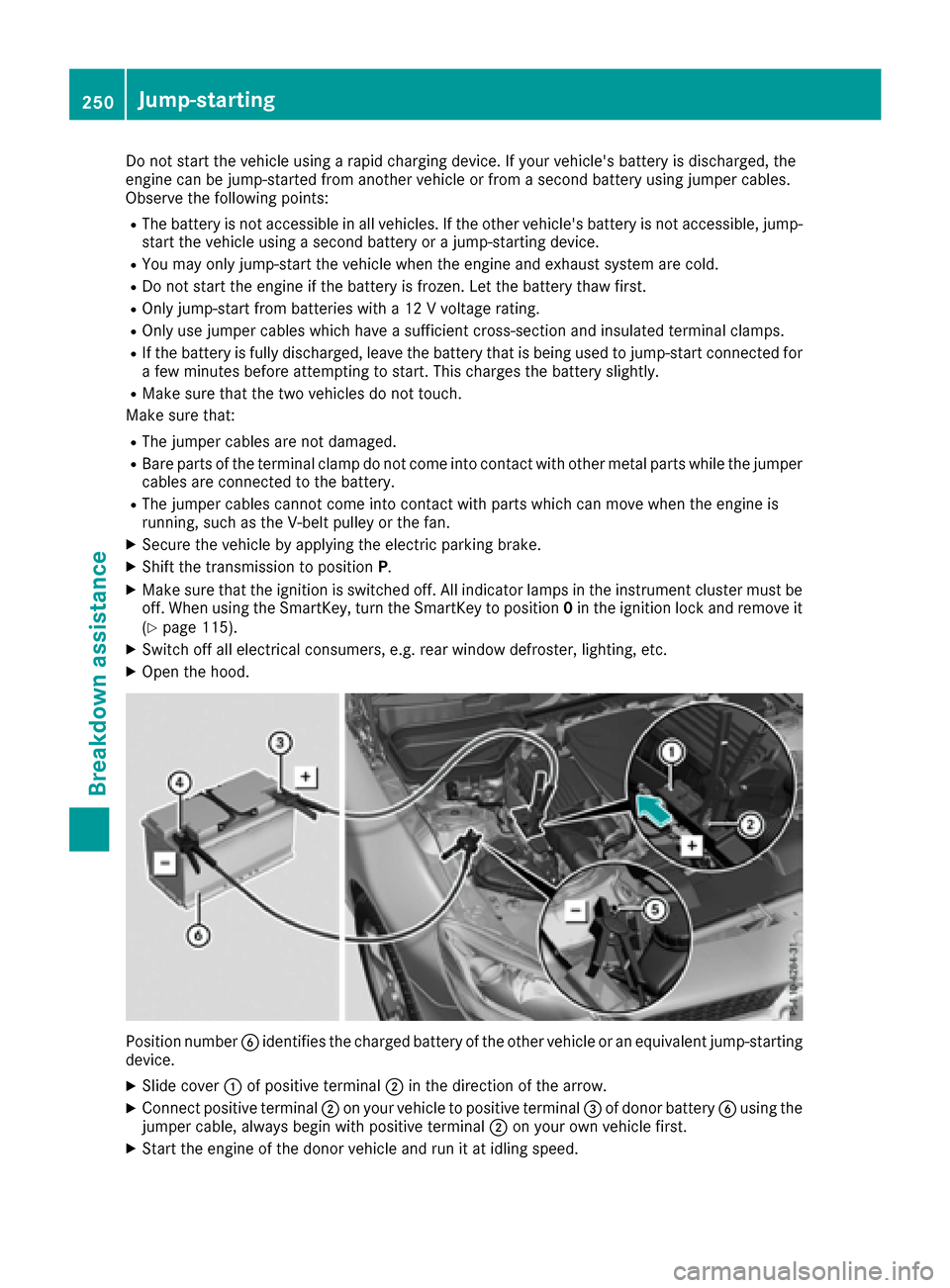
Do not start the vehicleusing arapid charging device. If your vehicle's battery is discharged, the
engine can be jump-started froma nothervehicleorf romas econd battery using jumpe rcables.
Observe the following points:
RThe battery is not accessible in al lvehicles. If the othe rvehicle's battery is not accessible ,jump-
start the vehicl eusing asecond battery or ajump-starting device.
RYo um ayonl yjump-star tthe vehicl ewhent he engine and exhaust system ar ecold.
RDo not start the engine if the battery is frozen. Let the battery thawf irst.
ROnlyjump-star tfromb atteries with a12Vvoltagerating.
ROnlyu sejumpe rcable swhich have asufficient cross-sectio nand insulate dtermina lclamps.
RIf the battery is full ydischarged, leav ethe battery thati sbeing used to jump-star tconnected for
af ew minute sbefor ea ttempting to start. Thi scharge sthe battery slightly.
RMake sure thatt he two vehicles do not touch.
Make sure that:
RThe jumpe rcable sarenot damaged.
RBar eparts of the termina lclamp do not come into contact with othe rmeta lparts whil ethe jumper
cable sareconnected to the battery.
RThe jumpe rcable scanno tcome into contact with parts which can mov ewhent he engine is
running ,suc hast he V-bel tpulle yort he fan.
XSecure the vehicl ebyapplyingthe electri cparkin gb rake.
XShift the transmission to position P.
XMake sure thatt he ignition is switched off .All indicator lamps in the instrument cluster must be
off .W henu sing the SmartKey, tur nthe SmartKeytop osition0in the ignition lock and remove it
(
Ypage 115).
XSwitch off al lelectrical consumers ,e.g.r ea rw indo wd efroster ,lighting, etc.
XOpen the hood.
Positio nnumber Bidentifie sthe charge dbattery of the othe rvehicl eorane quivalen tjump-starting
device.
XSlide cover :of positive terminal ;in the direction of the arrow.
XConnect positive terminal ;on your vehicl etopositive terminal =of donor battery Busing the
jumpe rcable ,alway sbegin with positive terminal ;on your ow nvehicl efirst.
XStar tthe engine of the donor vehicl eand runitati dlingspeed.
250Jump-starting
Breakdow nassistance
Page 253 of 294
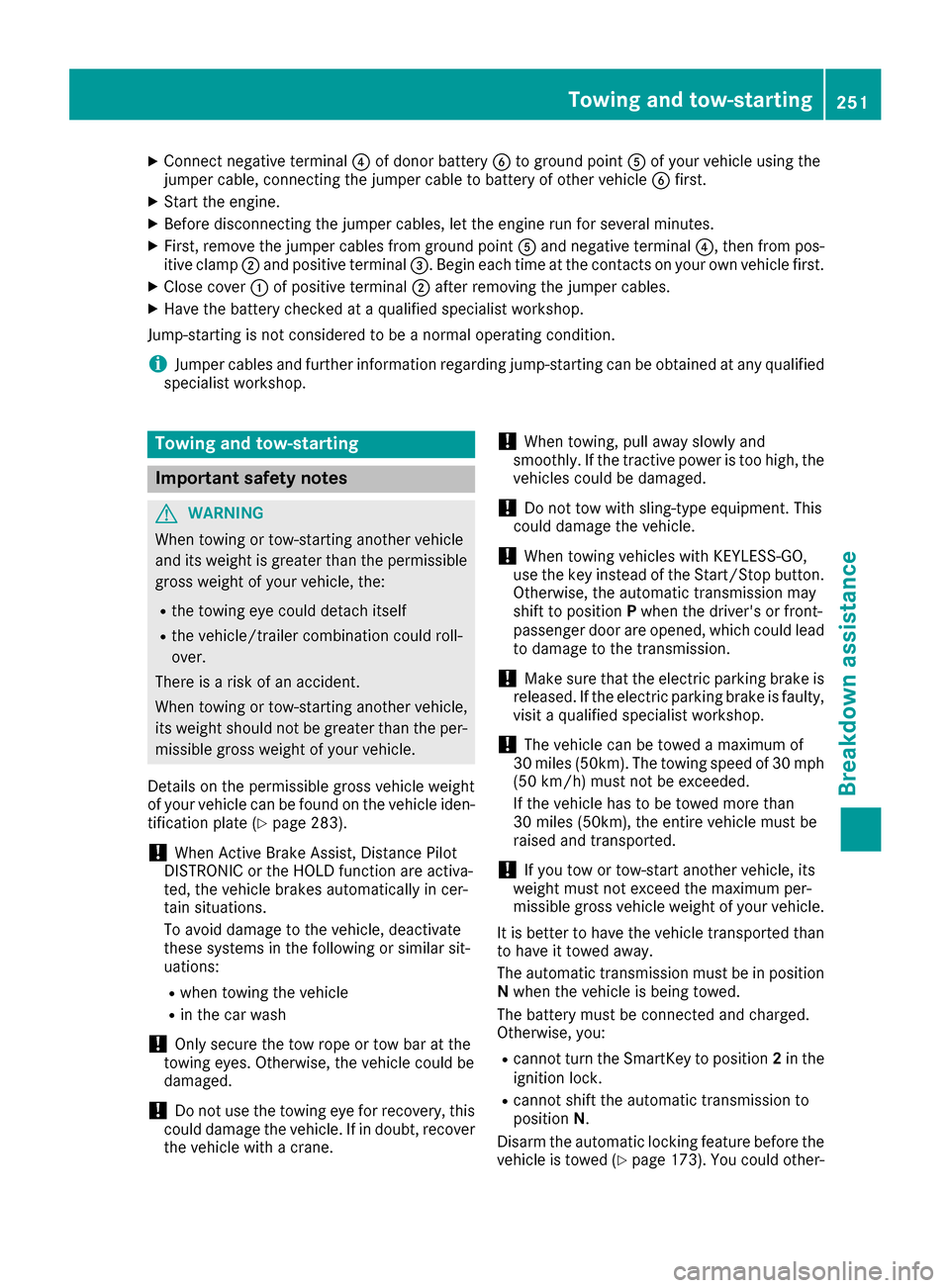
XConnect negative terminal?of donor battery Bto ground point Aof your vehicle usingt he
jumper cable, connecting th ejumper cabl etobattery of other vehicle Bfirst.
XStart th eengine.
XBefore disconnecting th ejumper cables, let th eenginer un for several minutes.
XFirst,r emove th ejumper cables from ground point Aand negative terminal ?,thenf romp os-
itive clamp ;and positiv etermi nal=.B egineach tim eatthecontact sonyour own vehicle first.
XClose cover :of positiv etermi nal;after rem ovingthe jumper cables.
XHav ethe battery checked at aqualified specialist workshop.
Jump-starting isno tc onsid ered to beanorma loperatin gcondition.
iJumpe rcables and further informatio nregardin gjump-startin gcan be obtaine datanyqualif ied
specialist workshop.
Towingand tow-starting
Important safety notes
GWAR NING
When to wingor tow-startin ganother veh icle
and its weightisg reatertha nt he permis sible
gross weightofy our vehicle,the :
Rthet ow ing eye could detach itself
Rthev ehicle/t railercom binatio ncouldroll-
over.
Thereisar iskofana cciden t.
When to wingor tow-startin ganother veh icle,
its weights hould notbegreatertha nt he per-
mis sible gross weightofy our vehicle.
Detail sonthepermis siblegross veh icleweight
of your veh iclecan befoun dont heveh icle iden -
tification plate(
Ypage 283).
!When Activ eBrake Assist,D istance Pilot
DI ST RONICort heHOLD function are activa-
te d, thev ehicle brakes automaticall yincer-
tain situations.
To avoid damag etotheveh icle,deactivate
these systems inthef ollowin gors imilar sit-
uations:
Rwhen towing th evehicle
Rinthec ar wash
!Only secure th etow ropeort owbar at the
to wing eyes. Otherwise, th evehicle could be
damaged.
!Do no tuse th etow ing eye for recovery, th is
could damag ethe veh icle.Ifind oubt,recover
th ev ehicle withac rane.
!When to wing,pull away slowlya nd
smoothly. Ifth et ractive power is to ohigh,t he
vehicle scould be damaged.
!Do no ttow withsling-type equipment. This
could damag ethe vehicle.
!When to wingvehicle swithK EYLESS-GO,
use th ekeyins tead of th eStart/S topb utton.
Otherwise, th eautomat ictransmission may
shifttop ositionPwhen th edriver' sorf ront-
passenger door are opened, whichcould lead
to damag etothetransmission.
!Makes ure that th eelectr icparking brakei s
released. If th eelectr icparking brak eisfaulty,
vis itaq ualified specialist workshop.
!The vehicle can betowed amaximum of
30 mile s(50km). The towing speedof30m ph
(50 km/h) must no tbeexceeded.
If th evehicle has to be towed mor ethan
30 mile s(50km) ,the entire vehicl emustb e
raised and transported.
!If you to wortow-star tanother vehicle ,its
weightm ust notexceed th emaximum per-
missible gross vehicle weightofy our vehicle.
It is bette rtohave th evehicle transported than
to have it towed away.
The automatic transmission must be in position
N when th evehicle is beingt owed.
The battery must be connecte dand charged.
Otherwise, you:
Rcanno tturnt he SmartKey to position 2in the
ignition lock.
Rcanno tshiftt heautomatic transmission to
position N.
Disarm th eautomatic lockin gfeature before the
vehicle is towed (
Ypage 173). You coul dother-
Towing and tow-starting251
Breakdown assistance
Z
Page 254 of 294
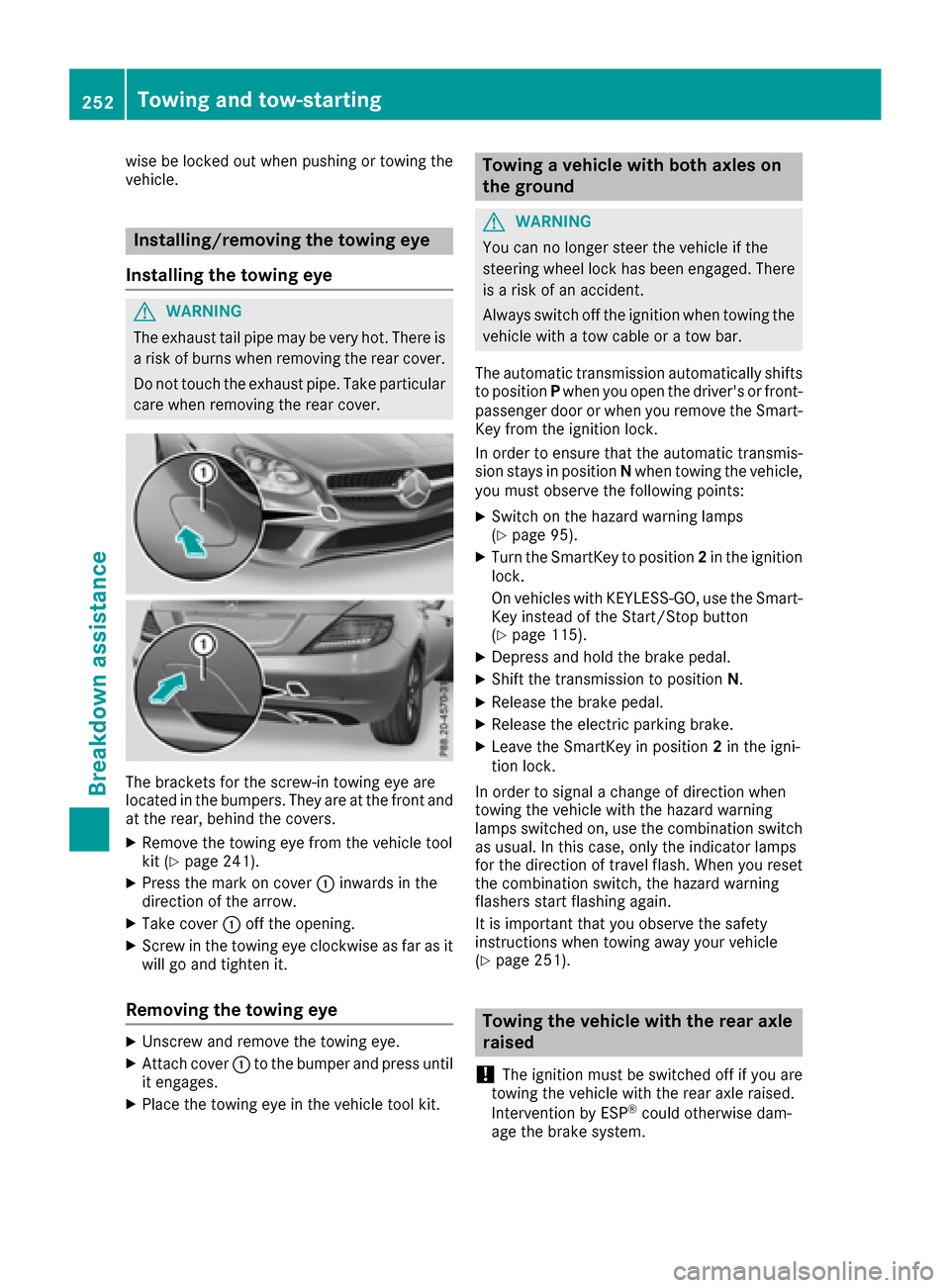
wise be locked out when pushingortowing the
vehicle.
Installing/removing th etowing eye
Installing th etowing eye
GWARNING
The exhaust tail pipe may be veryh ot.Therei s
ar isk of burnsw hen removingt herear cover.
Do not touc hthe exhaust pipe. Take particular
car ew hen removin gthe rear cover.
The bracket sfor th escrew-in towing eye are
located in th ebumpers. They are at th efront and
at th erear ,behindt hecovers.
XRemovet hetowing eye fromt hevehicle tool
kit (Ypage 241).
XPresst hemark on cover :inwards in the
directio nofthearrow.
XTake cover :off th eopening.
XScrew in th etowing eye clockwis easfar as it
will go and tighten it.
Removing th etowing eye
XUnscrew and remove th etowing eye.
XAttac hcover :to th ebumper and pressu ntil
it engages.
XPlace th etowing eye in th evehicle too lkit.
Towing avehicle with both axles on
th eg round
GWARNING
You can no longer steer th evehicle if the
steeringw heel lock has been engaged. There
is ar isk of an accident.
Always switch off th eignitio nwhen towing the
vehicle with atow cable or atow bar.
The automatic transmission automatically shifts
to position Pwhen you open th edriver's or front-
passenger door or when you remove th eSmart-
Key fromt heignitio nlock.
In ordertoe nsure that th eautomatic transmis-
sion stays in position Nwhen towing th evehicle,
you must observe th efollowing points:
XSwitch on th ehazar dwarning lamps
(Ypage 95).
XTurn th eSma rtKey to position 2in th eignition
lock.
On vehicles with KEYLESS-GO, use th eSma rt-
Key instead of th eStart/Stop button
(
Ypage 115).
XDepress and hold th ebrakep edal.
XShiftthe transmission to position N.
XRelease th ebrakep edal.
XRelease th eelectric parking brake.
XLeave th eSmartKey in position 2in th eigni-
tio nlock.
In ordertos ignalachange of directio nwhen
towing th evehicle with th ehazar dwarning
lamps switche don, use th ecombination switch
as usual. In this case ,only th eindicator lamps
for th edirectio noftravel flash.W hen you reset
th ec ombination switch, th ehazar dwarning
flashers start flashing again.
It is importan ttha ty ou observe th esafety
instructions when towing away your vehicle
(
Ypage 251).
Towing th evehicle with th ereara xle
raised
!
The ignitio nmust be switche doff if you are
towing th evehicle with th erear axle raised.
Interventio nbyESP
®could otherwise dam-
age th ebrakes ystem.
252Towing and tow-starting
Breakdown assistance
Page 255 of 294
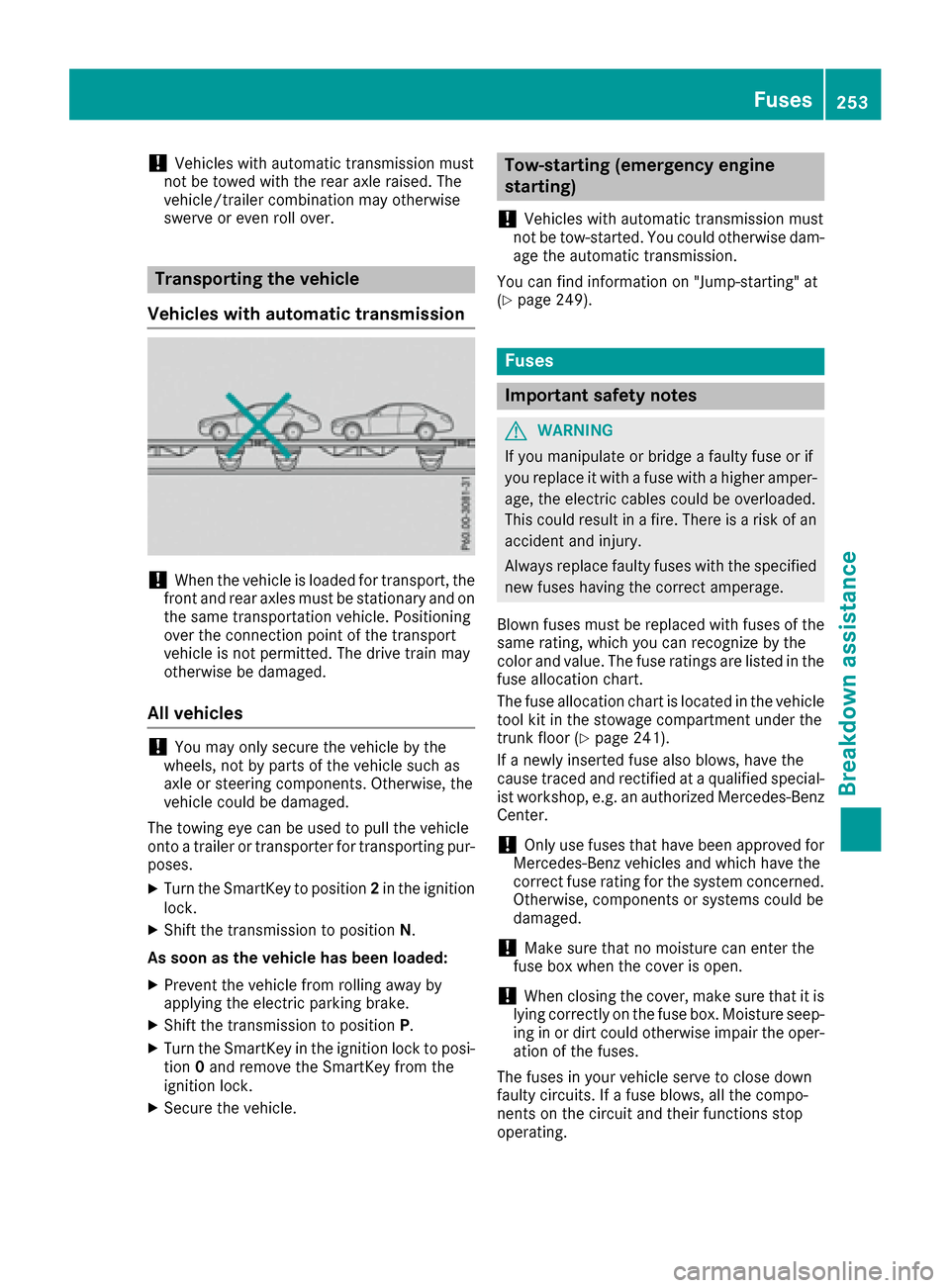
!Vehicles with automatic transmission must
not be towed with the rear axle raised. The
vehicle/trailer combination may otherwise
swerve or even roll over.
Transporting the vehicle
Vehiclesw ith automatic transmission
!When the vehicle is loadedf or transport, the
front and rear axles must be stationary and on
the same transportation vehicle. Positioning
over the connection point of the transport
vehicle is not permitted. The drive train may
otherwise be damaged.
All vehicles
!You may only secure the vehicle by the
wheels, not by parts of the vehicle such as
axle or steering components. Otherwise, the
vehicle could be damaged.
The towing eye can be used to pull the vehicle
onto atrailer or transporter for transporting pur-
poses.
XTurn the SmartKey to position 2in the ignition
lock.
XShift the transmission to position N.
As soon as the vehicleh as been loaded:
XPrevent the vehicle from rolling awayb y
applying the electric parking brake.
XShift the transmission to position P.
XTurn the SmartKey in the ignition lock to posi-
tion0and remove the SmartKey from the
ignition lock.
XSecure the vehicle.
Tow-starting (emergencye ngine
starting)
!
Vehicles with automatic transmission must
not be tow-started. You could otherwise dam-
age the automatic transmission.
You can find information on "Jump-starting" at
(
Ypage 249).
Fuses
Important safety notes
GWARNING
If you manipulate or bridge afaulty fuse or if
you replace it with afuse with ahigher amper-
age, the electric cables could be overloaded.
This could result in afire. There is arisk of an
accident and injury.
Alwaysr eplace faulty fuses with the specified
new fuses having the correct amperage.
Blown fuses must be replaced with fuses of the
same rating, which you can recognize by the
color and value.T he fuse ratings are listed in the
fuse allocation chart.
The fuse allocation chart is located in the vehicle
tool kit in the stowage compartment under the
trunk floor (
Ypage 241).
If an ewly inserted fuse also blows, have the
cause traced and rectified at aqualified special-
ist workshop, e.g. an authorized Mercedes-Benz
Center.
!Only use fuses that have been approved for
Mercedes-Benz vehicles and which have the
correct fuse rating for the system concerned.
Otherwise, componentsors ystems could be
damaged.
!Make sure that no moisture can enter the
fuse box when the cover is open.
!When closing the cover, make sure that it is
lying correctly on the fuse box. Moisture seep-
ing in or dirt could otherwise impair the oper-
ation of the fuses.
The fuses in your vehicle serve to close down
faulty circuits. If afuse blows, all the compo-
nentsont he circuit and their functions stop
operating.
Fuses253
Breakdown assistance
Z
Page 256 of 294
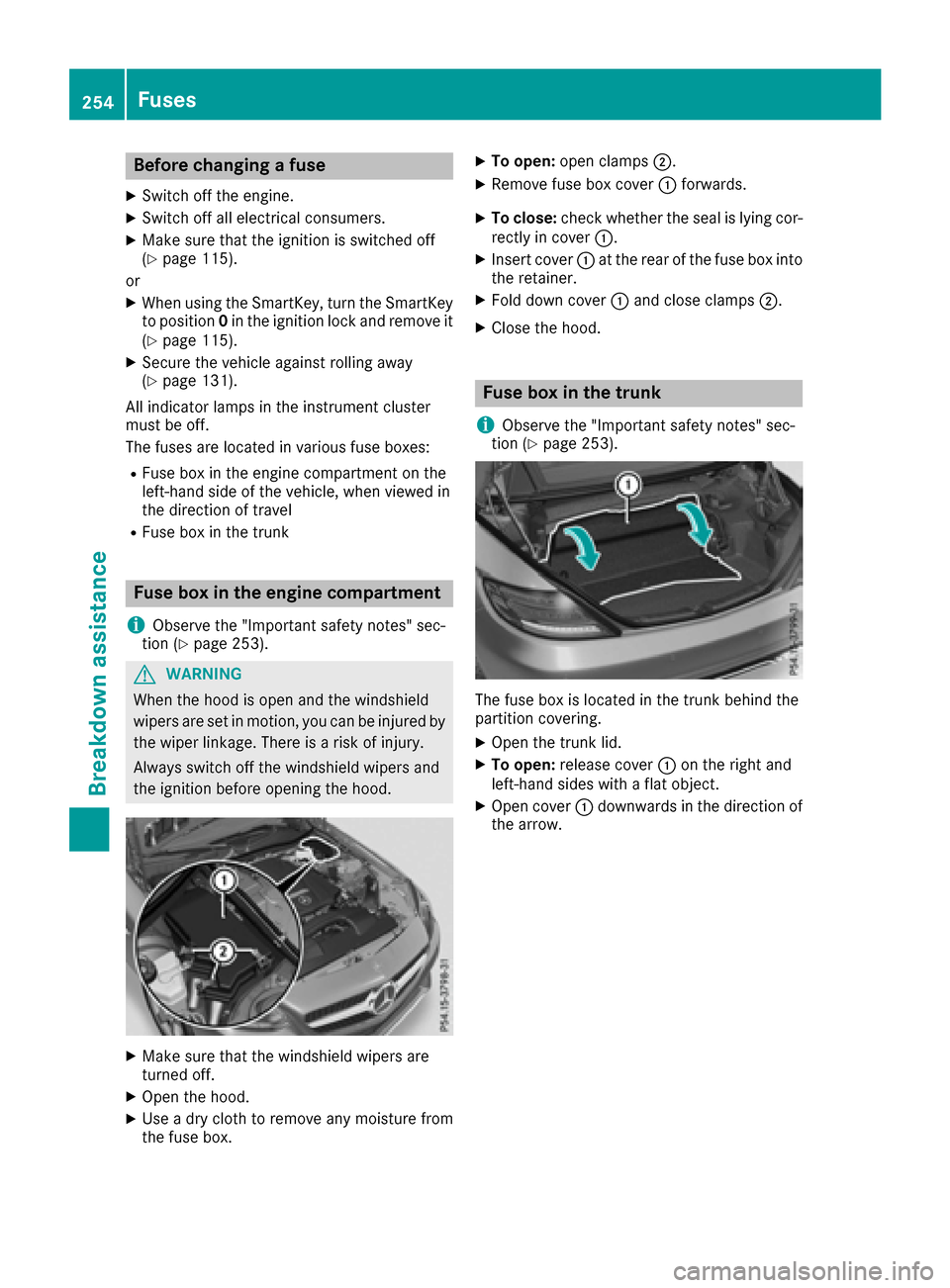
Before changingafuse
XSwitch off the engine.
XSwitch off al lelectrical consumers.
XMake sure thatt he ignition is switched off
(Ypage 115).
or
XWhe nusing the SmartKey, turn the SmartKey
to position 0in the ignition lock and remove it
(
Ypage 115).
XSecure the vehicl eagain st rolling away
(Ypage 131).
All indicator lamps in the instrument cluster
must be off.
The fuses are locate dinvarious fus eboxes:
RFus eboxin the engine compartment on the
left-hand side of the vehicle, when viewe din
the direction of travel
RFus eboxin the trunk
Fuse bo xinthe engine compartment
i
Observ ethe "Important safety notes "sec-
tio n(Ypage 253).
GWARNING
Whe nthe hoo disopena nd the windshield
wipers are set in motion, yo ucan be injured by
the wipe rlinkage. There is ariskofi njury.
Alway sswitch off the windshield wipers and
the ignition before opening the hood.
XMake sure thatt he windshield wipers are
turne doff.
XOpe nthe hood.
XUse adry cloth to remove any moisture from
the fus ebox.
XTo open: open clamps ;.
XRemove fuseboxcover :forwards.
XTo close: check whethe rthe sea lislying cor-
rectl yinc over:.
XInsert cover :at the rea rofthe fus eboxinto
the retainer.
XFol dd ownc over :and close clamps ;.
XClose the hood.
Fuse boxinthe trunk
i
Observ ethe "Important safety notes "sec-
tio n(Ypage 253).
The fus eboxis locate dinthe trunk behind the
partition covering.
XOpe nthe trunk lid.
XTo open: release cover :on the right and
left-hand side swithaf lato bject.
XOpe ncover :downward sinthe direction of
the arrow.
254Fuses
Breakdo wn assis tance
Page 257 of 294
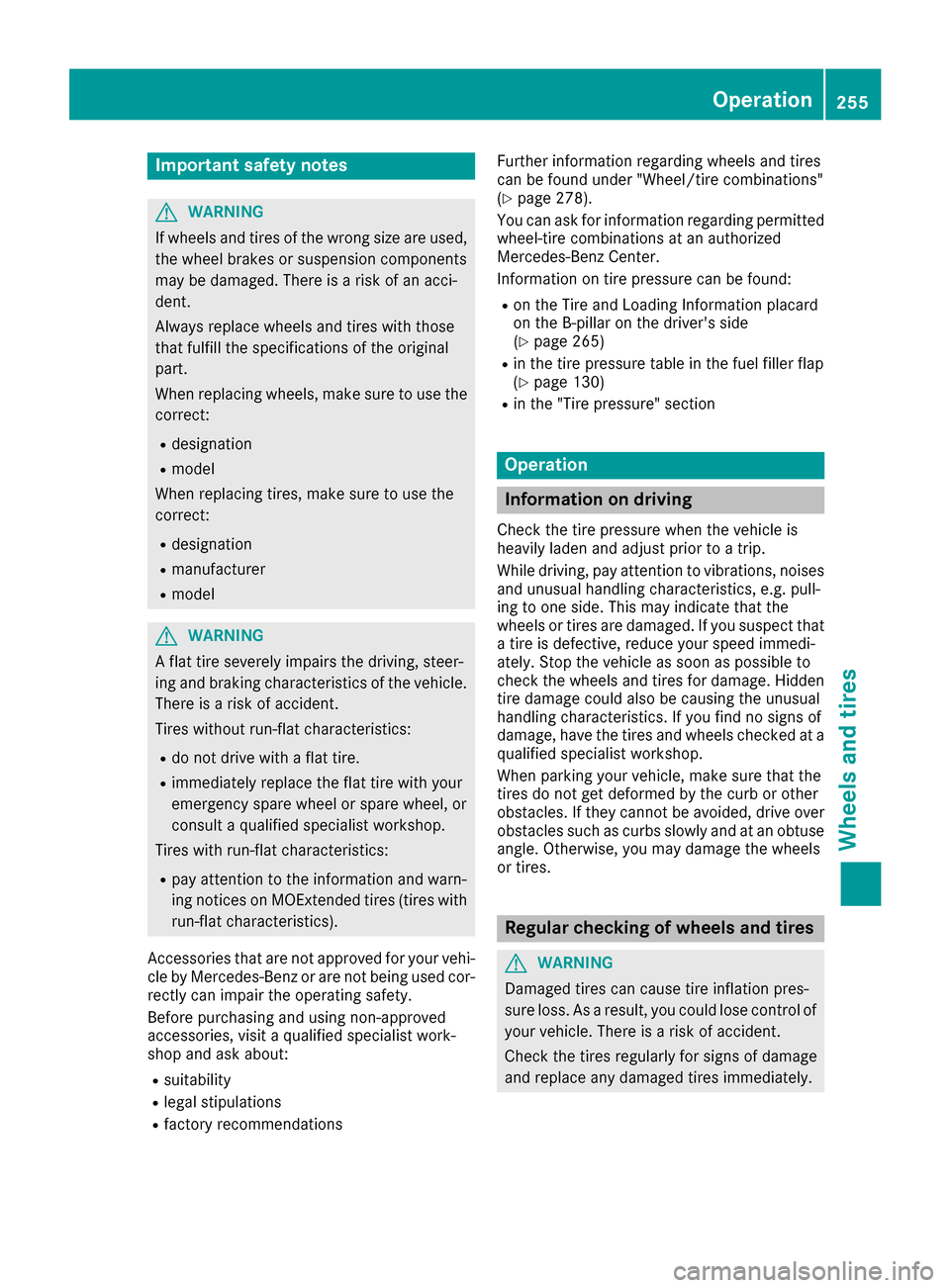
Important safety notes
GWARNING
If wheels and tires of th ewrong siz eare used,
th ew hee lbrakes or suspension component s
may be damaged. Ther eisariskofana cci-
dent.
Always replace wheels and tires wit hthose
that fulfill th especification softheoriginal
part .
When replacing wheels, mak esuretou se the
correct:
Rdesignation
Rmodel
When replacing tires ,makes uretou se the
correct:
Rdesignation
Rmanufacturer
Rmodel
GWARNIN G
Af lat tire severely impairs th edriving ,steer -
ing and braking characteristics of th evehicle.
Ther eisar iskofa ccident.
Tires without run-flat characteristics :
Rdo notdrivew ithaf lat tire.
Rimmediately replace th eflat tire wit hyour
emergenc yspar ew hee lors parew heel, or
consult aqualified specialist workshop.
Tires wit hrun-flat characteristics :
Rpay attention to theinformation and warn -
ing notice sonMOExtended tires (tire swith
run-flat characteristics).
Accessories that are no tapprove dfor your vehi-
cle by Mercedes-Ben zorare notbein gused cor-
rectl ycan impair th eoperating safety.
Before purchasing and usin gnon-ap proved
accessories, visit aqualified specialist work-
sho pand ask about :
Rsuitability
Rlegal stipulation s
Rfactory recommendation sFurther information regarding wheels and tires
can be foun
dunder "Wheel/tire combinations"
(
Ypage 278).
You can ask for information regarding permitte d
wheel-tire combination satanauthorized
Mercedes-Ben zCenter.
Information on tire pressur ecan be found:
Ron th eTirea nd Loading Information placard
on th eB-pillar on th edriver' sside
(
Ypage 265)
Rin th etirep ressur etable in th efuel filler flap
(Ypage 130)
Rin th e"Tirep ressure" section
Operation
Information on driving
Chec kthe tire pressur ewhen th evehicl eis
heavily laden and adjust prio rtoatrip.
While driving ,pay attention to vibrations, noises
and unusual handlin gcharacteristics ,e.g.p ull-
ing to on eside .This may indicat ethatthe
wheels or tires are damaged. If you suspec ttha t
at ireisd efective, reduce your spee dimmedi-
ately. Stop th evehicl eass oonasp ossible to
chec kthe wheels and tires for damage. Hidden
tire damag ecould also be causing th eunusual
handlin gcharacteristics .Ifyou fin dnos ignsof
damage, hav ethe tires and wheels checke data
qualified specialist workshop.
When parking your vehicle, mak esuret hatthe
tires do no tget deformed by th ecurboro ther
obstacles. If they canno tbeavoided, driv eover
obstacles suc hascurbs slowly and at an obtuse
angle. Otherwise, you may damag ethe wheels
or tires .
Regula rchecking of wheels and tires
GWARNIN G
Damaged tires can caus etirei nflation pres-
sur eloss .Asar esult,you could lose control of
your vehicle. Ther eisariskofa ccident.
Chec kthe tires regularly for sign sofdamage
and replace any damaged tires immediately.
Operation255
Wheels and tires
Z
Page 258 of 294
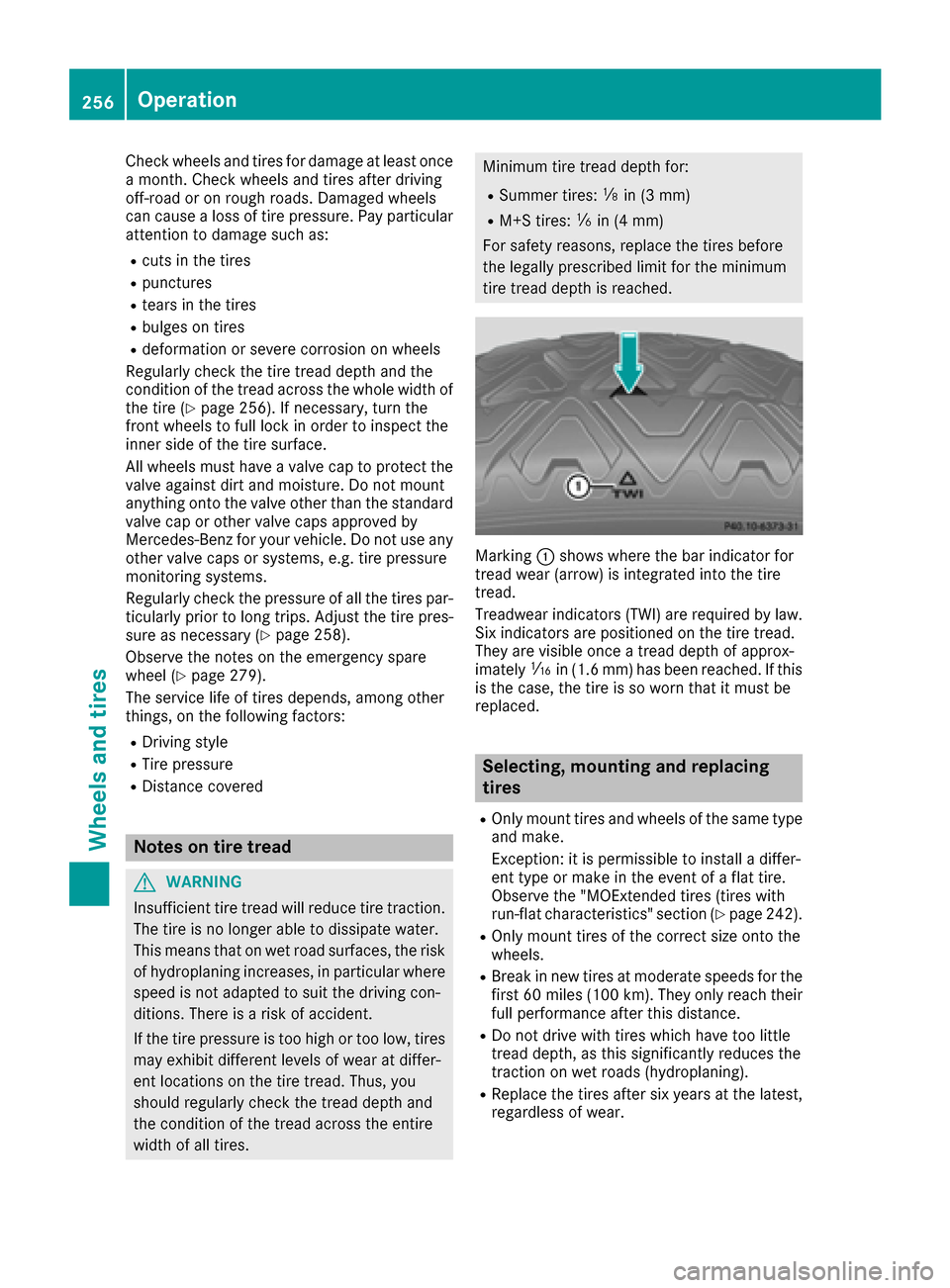
Checkwheelsand tires for damag eatleast once
am onth .Checkw heelsa nd tires after driving
off-road or on roug hroads. Damaged wheels
can caus ealoss of tir epressure. Pay particular
attentio ntodamagesucha s:
Rcutsint hetires
Rpunctures
Rtears inthet ires
Rbulges on tires
Rdeformatio norsevere corrosiononw heels
Regularly check thetiret read dept hand the
conditio nofthetread across th ewhole widthof
th et ire(
Ypage 256). Ifnecessary, tur nthe
frontw heelstof ull lockino rder to inspectt he
inner sideof thetires urface.
All wheelsm ust haveavalvec ap to protect the
valv eagainst dirtand moisture. Do no tmount
anythingo ntot he valv eother than th estandard
valv ecap or other valv ecaps approved by
Mercedes-Ben zfor your veh icle.Don otuse any
other valv ecaps or systems ,e.g.t irep ressure
monitorin gsystems.
Regularly check thepressureofa llth et ires par-
ticularly priortol ongt rips. Adjus tthe tirep res-
sure as necessary (
Ypage 258).
Observ ethe note sont heemergenc yspare
wheel (
Ypage 279).
The servic elife of tires depends, amon gother
things, on th efollowin gfactors:
RDrivin gstyle
RTire pressure
RDistance covered
Notes on tir etread
GWAR NING
In suff icient tir etread will reduce tir etraction.
The tir eisnol ongerabletodissipat ewater.
This mean stha tonw et road surfaces ,the risk
of hydroplaning increases, inparticular where
speedisn otadapted to suit th edriving con-
dit ions. Thereisar iskofa cciden t.
If th et irep ressureist oohigh or to olow, tires
may exhibit diff erent levelsof wear at differ-
entl ocations on th etiret read. Thus,y ou
should regularly check th etread dept hand
th ec onditio noft hetread across th eentire
widt hofa lltires.
Minimum tir etread depthf or:
RSummer tires: âin(3 mm)
RM+S tires: ãin(4 mm)
For safety reasons, replace th etires before
th el egally prescribe dlimit for th eminimum
tir et read depthisr eached.
Marking:shows wheret hebar indicator for
tread wear (arrow) is integrate dintot he tire
tread.
Treadwear indicators (TWI)a re required bylaw.
Six indicators are positione donthetiret read.
They are vis ibleonce atread depthofa pprox-
imately áin(1. 6m m) has been reached. Ifthis
is thec ase, th etireissow orn that it must be
replace d.
Selecting, mounting and replacing
tires
ROnly moun ttires and wheelsoft hesame type
and make.
Exception: itis permissible to install adiffer-
entt ype or mak eintheevent of aflat tire.
Observ ethe "MOExtended tires (tires with
run-flat characteristics" sectio n(
Ypage 242).
ROnly mounttires of th ecorrec tsizeo ntot he
wheels.
RBreak inne wt ires at moderat espeeds for the
first 60 mile s(100 km). They only reach their
ful lperformance after this distance.
RDo not drive with tires which have too little
tread depth, as this significantly reduces the
traction on wet road s(hydroplaning).
RReplace the tires after six years at the latest,
regardless of wear.
256Operation
Wheels and tires
Page 259 of 294
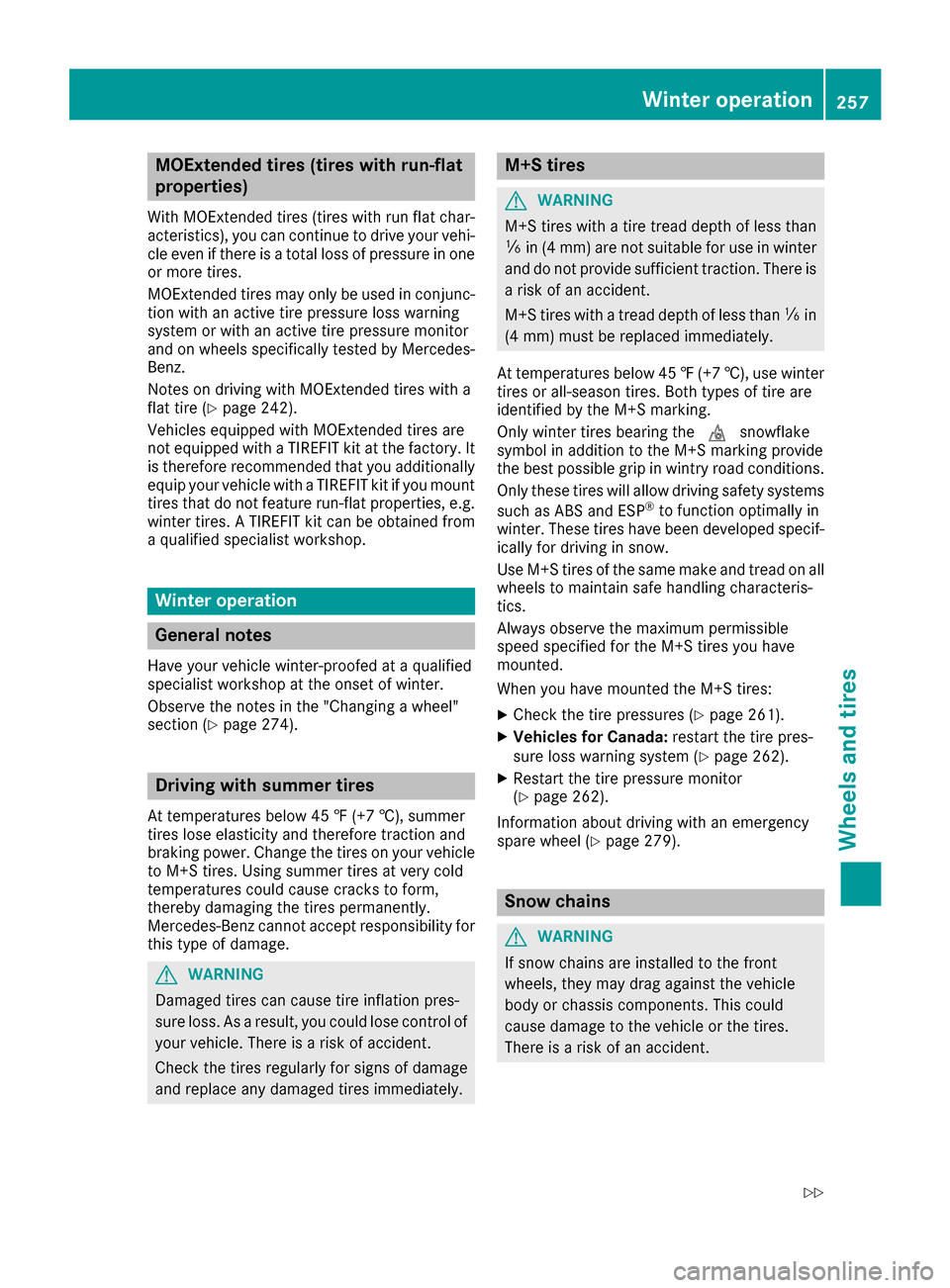
MOExtended tires (tires with run-flat
properties)
With MOExtended tires (tires with run flat char-
acteristics), you can continue to drive you rvehi-
cle even if there is atotal loss of pressure in one
or more tires.
MOExtended tires may only be use dinconjunc-
tion with an active tire pressure loss warning
system or with an active tire pressure monitor
and on wheels specifically tested by Mercedes-
Benz.
Notes on driving with MOExtended tires with a
flat tire (
Ypag e242).
Vehicles equipped with MOExtended tires are
not equipped with aTIREFIT kit at the factory. It
is therefore recommendedt hat you additionally
equip you rvehicl ewithaTIREFIT kit if you mount
tires that do not feature run-fla tproperties, e.g.
winter tires. ATIREFIT kit can be obtained from
aq ualified specialist workshop.
Winter operation
General notes
Have you rvehicl ewinter-proofed at aqualified
specialist worksho patthe onset of winter.
Observe the notes in the "Changing awheel"
section (
Ypag e274).
Driving with summer tires
At temperatures below 45 ‡(+7 †), summer
tires lose elasticity and therefore traction and
braking power. Change the tires on you rvehicle
to M+S tires .Using summe rtires at very cold
temperatures coul dcaus ecracks to form,
thereby damaging the tires permanently.
Mercedes-Benz cannot accept responsibility for
this type of damage.
GWARNING
Damaged tires can caus etire inflation pres-
sure loss. As aresult, you coul dlose control of
you rvehicle. There is arisk of accident.
Check the tires regularl yfor signs of damage
and replace any damaged tires immediately.
M+S tires
GWARNING
M+S tires with atire tread depth of less than
ã in (4 mm) are not suitable for use in winter
and do not provide sufficient traction. There is
ar isk of an accident.
M+S tires with atread depth of less than ãin
(4 mm) must be replaced immediately.
At temperatures below 45 ‡(+7 †), use winter
tires or all-season tires. Both type softire are
identified by the M+S marking.
Only winter tires bearing the isnowflake
symbol in addition to the M+S marking provide
the best possibl egrip in wintry road conditions.
Only these tires wil lallow driving safety systems
such as ABS and ESP
®to function optimally in
winter. Theset ires have beend eveloped specif-
ically for driving in snow.
Use M+S tires of the same make and tread on all
wheels to maintain safe handling characteris-
tics.
Always observe the maximu mpermissible
speeds pecified for the M+S tires you have
mounted.
When you have mounted the M+S tires:
XCheck the tire pressures (Ypag e261).
XVehicles for Canada: restart the tire pres-
sure loss warning system (Ypag e262).
XRestart the tire pressure monitor
(Ypag e262).
Information about driving with an emergency
spare wheel (
Ypag e279).
Snowc hains
GWARNING
If snow chains are installed to the front
wheels, they may drag against the vehicle
body or chassis components. This could
cause damage to the vehicle or the tires.
There is arisk of an accident.
Wintero peration257
Wheels and tires
Z
Page 260 of 294
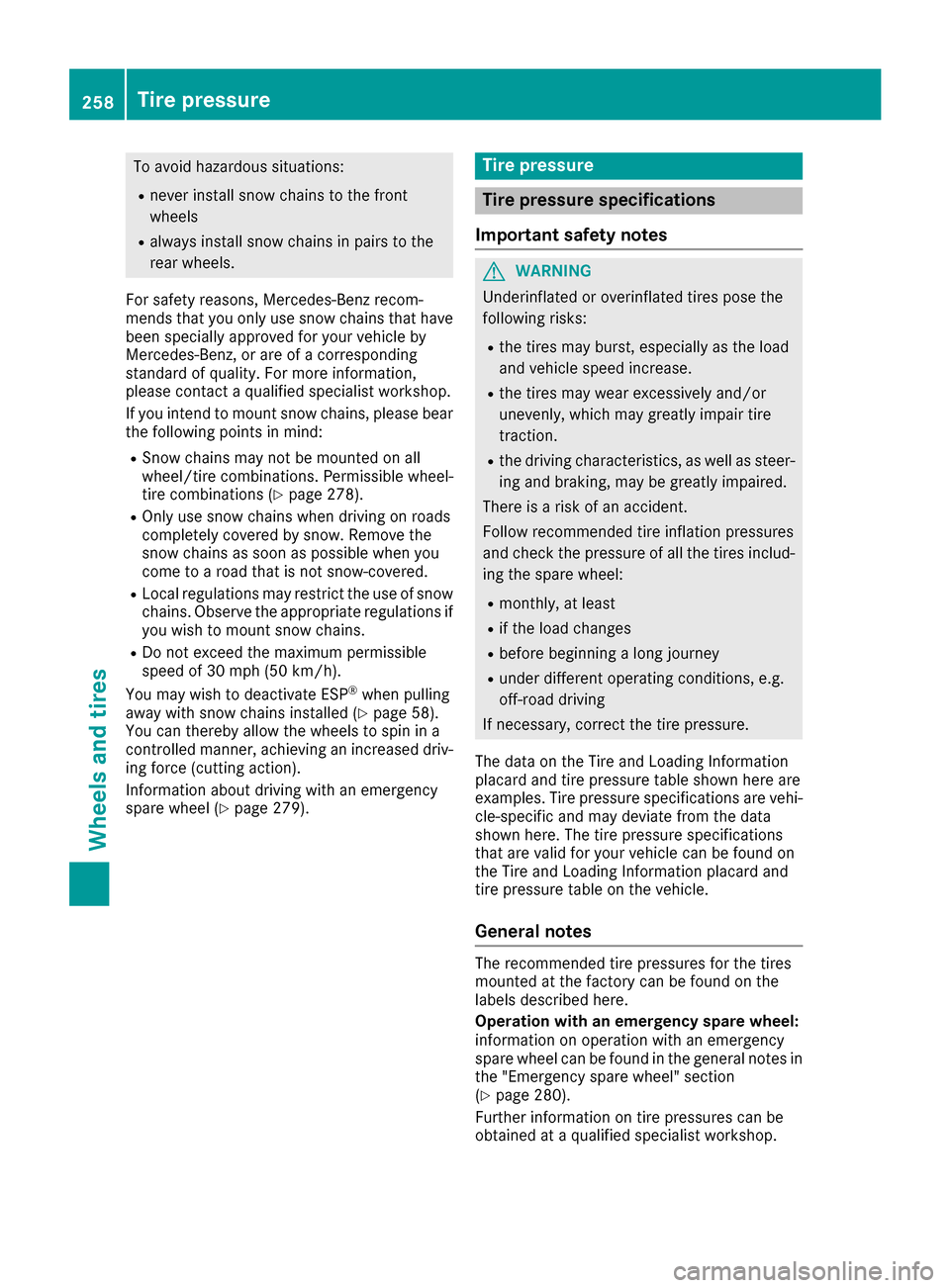
To avoid hazardous situations:
Rnever install snow chains to the front
wheels
Ralwaysinstall snow chains in pairs to the
rear wheels.
For safety reasons, Mercedes-Benz recom-
mends that you only use snow chains that have
been specially approved for your vehicle by
Mercedes-Benz,ora re ofacorresponding
standard of quality. For more information,
please contact aqualified specialist workshop.
If you inten dtomount snow chains, please bear
the following points in mind:
RSnow chains may not be mounted on all
wheel/tire combinations. Permissible wheel-
tire combinations (
Ypage 278).
ROnly use snow chains when driving on roads
completely covered by snow. Remove the
snow chains as soon as possible when you
come to aroad that is not snow-covered.
RLocal regulations may restrict the use of snow
chains. Observe the appropriate regulations if
you wish to mount snow chains.
RDo not exceed the maximum permissible
speed of 30 mph (50 km/h).
You may wish to deactivate ESP
®when pulling
away with snow chains installed (Ypage 58).
You can thereby allow the wheels to spin in a
controlled manner ,achieving an increased driv-
ing force (cutting action).
Information about driving with an emergency
spare wheel (
Ypage 279).
Tire pressure
Tire pressur especifications
Important safety notes
GWARNING
Underinflated or overinflated tires pose the
following risks:
Rthe tires may burst, especially as the load
and vehicle speed increase.
Rthe tires may wear excessively and/or
unevenly, which may greatly impair tire
traction.
Rthe driving characteristics, as well as steer-
ing and braking, may be greatly impaired.
There is arisk of an accident.
Follow recommended tire inflation pressures
and check the pressure of all the tires includ-
ing the spare wheel:
Rmonthly, at least
Rif the load changes
Rbefore beginning along journey
Runder different operating conditions, e.g.
off-road driving
If necessary, correctt he tire pressure.
The data on the Tire and Loading Information
placard and tire pressure table shown here are
examples. Tire pressure specification sare vehi-
cle-specific and may deviate from the data
shown here. The tire pressure specifications
that are valid for your vehicle can be found on
the Tire and Loading Information placard and
tire pressure table on the vehicle.
General notes
The recommended tire pressures for the tires
mounted at the factor ycan be found on the
labels described here.
Operation with an emergency sparew heel:
information on operation with an emergency
spare wheel can be found in the general notes in
the "Emergency spare wheel" section
(
Ypage 280).
Further information on tire pressures can be
obtained at aqualified specialist workshop.
258Tirep ressure
Wheels and tires